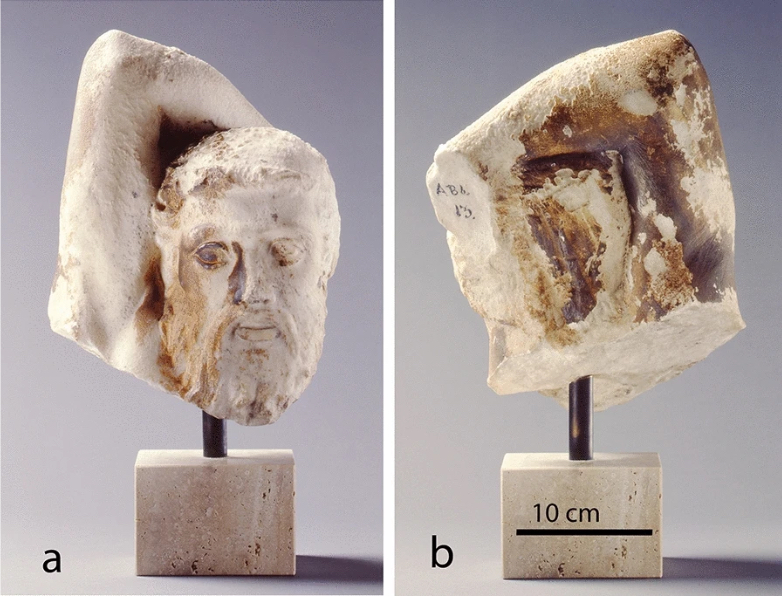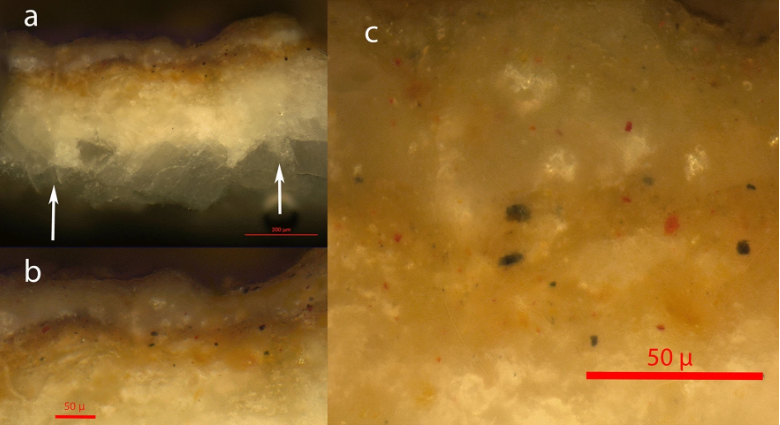The National Museum of Denmark has been safeguarding since 1688—when the museum was still the Royal Danish Kunstkammer—a monumental marble head of a bearded man: the head of one of the centaurs from a frieze depicting the mythological battle between the centaurs and the Lapiths that was once part of the ancient Greek Parthenon temple on the Acropolis in Athens. The head was sent as a gift to King Christian V by the Danish captain Moritz Hartmand while serving in the Venetian navy during the bombardment of Athens in 1687.

More than for its origin and magnificence, however, the head has gained historical notoriety for the scientific enigma it bears, shared with other pieces of the same origin housed in other museums: it is partially covered by a thin brown film or layer of a substance of unknown origin. The mystery has puzzled the scientific (and archaeological) community since it was first identified and examined in 1830 by experts from the British Museum on other fragments of the Athenian Parthenon held by the institution.
Enigma 1
At the time, the question that motivated the British experts was whether the brown film was the result of some kind of treatment or paint applied to the marble figures in antiquity. They ruled this out. They concluded that it could either be a film formed naturally by atmospheric reactions, or that it was the result of iron compounds migrating from the interior of the marble to the surface.
However, years later, in 1851, and after examining the stain, the eminent British historian F. C. Penrose rejected the migrating iron explanation and suggested that the stain was caused by a wash of ochre (a pigment made from iron oxide mixed with sand and clay) that had been applied to the marble to tone down its brilliant whiteness.
However, both the museum experts’ and Penrose’s interpretations were mostly guesswork, based on appearance and historical origin, rather than reliable scientific evidence. In fact, it was not until 1853 that the eminent German chemist Justus von Liebig carried out the first chemical analysis of the residue. He concluded that the film was essentially a layer of oxalates (salts of oxalic acid). Subsequent analyses would establish that it was the minerals whewellite (CaCO2O4.H2O) and weddellite (CaCO2O4.2H2O).

Liebig was unable to say anything more about their origin, but his analysis was very revealing because oxalic acid is an organic acid. This discovery seemed to point to a biological origin. This led to two main hypotheses that are still valid today. The first suggests that the film was formed from the remains of a lichen or some other organism, such as an algae, fungus or bacterium, which had grown and colonised the surface of the marble at some point, presumably at a time when weather conditions were favourable. The second possibility is that it was the result of the decomposition of some organic material that had been applied to the marble in an earlier period as a protective or colouring treatment. Since ancient times, and until the advent of the chemical industry, it was common practice to apply varnishes based on egg whites, milk or resins and vegetable juices for such purposes.
Enigma 2: A thorough chemical examination…
….will allow you to find the ten German chemists of the 19th century hidden in this alphabet soup. You will know them by their achievements:
- Discovered the structure of benzene
- Developed the synthesis of ammonia
- Discovered cadmium
- Invented a revolutionary funnel
- Developed the synthesis of indigo
- Devised a process for obtaining nitric acid from ammonia on an industrial scale
- Invented meat concentrates
- Discovered rubidium
- Was the father of the third law of thermodynamics
- Successfully synthesised the amino acid tyrosine

That was the situation when Danish researchers took up the challenge of carrying out a new, exhaustive examination, equipped with all the sophisticated and sensitive analytical instruments available today.
And the results, published this year, far from solving the mystery, have made it even more complex by revealing that the supposed brown film is actually made up of two layers of approximately equal thickness, perfectly distinguishable from each other, with a very similar oxalate-based composition, differing only in the trace elements present. However, despite this almost identical composition, the perfect separation of the two layers suggests that they have different origins. In other words, they were produced from different processes or at chronologically different times, not simultaneously but sequentially. Furthermore, the study seems to rule out what was previously considered to be the most certain: a biological origin. Since the proteomic analysis did not yield any positive results, there was no evidence of the presence of proteins, or the remains of proteins, as would be expected in the case of a biological substance or the remains of an organism.
Enigma 3: The signature of the centaur
The Danish centaur’s head is not the only mysterious one. Another head with a mysterious inscription has recently been discovered. It was apparently part of a statue depicting a legendary centaur, and some experts claim that the inscription may hold the key to determining who it belongs to:
Shsilioptifmgmgh
And to add to the mystery, the Danish researchers have identified a third (white) layer beneath the two brown layers, which is much richer in phosphorus than the brown layers, despite containing no phosphorus minerals. This in turn has led to two possible (and new) hypotheses about its origin: that it is a surface vein of marble enriched in this element (i.e. marble with many phosphorous impurities trapped in its structure); or that it is the result of some unknown treatment, but not of organic origin, since there are no traces of proteins.
Will we ever know the origin of this mysterious brown stain, or will it remain a mystery with mythological overtones?
Solutions
Comments on this publication